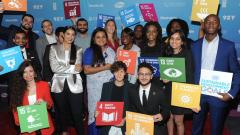- عربي
- 中文
- English
- Français
- Русский
- Español
Opening Statement at the HLPF Side Event: "Partnerships for Accelerated Sustainable Energy Development and Enhanced Resilience Building"
Statement by Ms. Fekitamoeloa Katoa ‘Utoikamanu, High Representative for the Least Developed Countries, Landlocked Developing Countries and Small Island Developing States
12 July 2019
New York, USA
Excellencies,
Distinguished delegates,
Ladies and gentlemen,
Ensuring accessto affordable, reliable and modern energy for all isthe key driver, the key means to realizing key SDGs and to ultimately ensuring no one is left behind. In short, energy is both a basic human right and an enabler for sustainable development. It is key in improving livelihoods; enhancing industrialization and structural economic transformation; responding to the challenges of climate change , for fostering regional integration through regional power pools, and increasing trade facilitation that is so necessary for reducing the high trade costs that the LLDCs face. The 2030 Agenda for Sustainable Development set and so did the Vienna Programme of Action for LLDCs. They are not separate but complementary commitments made. Both stress the need to expand and upgrade infrastructure forsupply, transmission and distribution of modern and renewable energy servicesin rural and urban areas in LLDCs.
We are Midway in the implementation of the Vienna Programme of Action and we already are four years into the implementation of the 2030 Agenda for Sustainable Development. Yes, some progress has been achieved. But we must work more, we must work faster. The LLDCs continue to lag behind when we look at global averages. Yes, the average percentage of population with access to electricity in LLDCs increased from 49.5% in 2014 to 56.3% in 2017. At a global scale the average is at 88.8% in 2017. So more than 30 per cent higher!! Access to clean fuels and technologies for cooking in LLDCs increased only marginally from 28.1% in 2015 to 28.8% in 2017.
Again, at the global level the average stood at 59.8% in 2017. These are averages - they are telling but they also hide significant intra- and intercountry variations and notably those between rural and urban areas. Now, add to this the high level of vulnerability of the LLDCs to the impacts of climate change. LLDCs are predominantly located in dryland regions where the impact of climate change is at best more pronounced and at worst catatstrophic.
Some LLDCs have a large proportion of their land in mountainous terrain suffering from land- and mudslides, flooding and given that LLDCs tend to be heavily dependent on climate-sensitive resources for agriculture, forestry, water, and fisheries, I let you imagine what this means for people's livelihoods. The adverse impacts of climate change already severely affect many LLDCs and make it all the more harder and complex for the LLDCs to achieve sustainable development. LLDCs do not at all lack the determination to transform their economies and societies into resilient and sustainable ones. They know that this is critical to translating the global community's climate change goals into reality. And we all know how it is modern, sustainable energy which is at the core of sustainability and resilience.
Affordable, scalable, renewable energy solutions are now accessible to give countries a chance to leapfrog to cleaner, more resilient economies. Achieving this transition and increasing access requires a strong national vision, leadership, solid national strategies and implementation capacities together with requisite human and institutional capacities and above all financial resources. To make this happen, I see at the core an urgent need for greater partnerships. Partnerships at all levels - national public sector, the private sector, development partners, multilateral financial institutions, the United nations system and other international, regional, sub-regional and national organizations. Excellencies, Distinguished Delegates, Ladies and Gentlemen As I see it, we are at a critical juncture and we have a great strategic opportunity this year to push forward in ensuring we do not leave the LLDCs behind.
We have the High level Mid-term Review of the Vienna Programme of Action take place on 5 and 6 December 2019, here in New York. The high-level meeting will review progress and identify practical and forwardlooking ways and means to accelerate the implementation of the Vienna Programme of Action and the SDGs. In my view, a lot of the success rests on having a solid and truly participatory process leading up to the meeting. We have already successfully concluded 3 regional preparatory meetings jointly organized with the UN Regional Economic Commissions in the Euro-Asia, Africa and Latin America regions.
Energy and climate change received considerable focus in all preparatory meetings, including the need to scale up investment, build capacity and enhance the enabling environment for expanding renewable energy in LLDCs. So, it is against this background that I do look forward to our discussion today. I look forward to hearing about experiences on how different partnerships have or can support LLDCs to accelerate sustainable energy development and enhanced resilience building to climate change. The outcome of today's discussions will feed into the preparatory process of the midterm review. I assure you that OHRLLS is very committed to closely working with the LLDCs and all partners to support effective implementation of the Vienna Programme of Action and achievement of the SDGs.
To conclude, allow me to share with you a policy brief on landlocked developing countries that my office and partners have prepared as part of the work of the SDG7 Technical Advisory Group to contribute to the upcoming midterm reviews. I thank you





